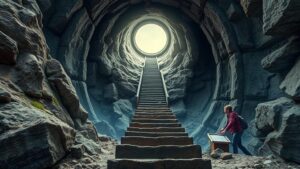Mapping “phantom cities” that appear in historical accounts but remain undiscovered.
Mapping Phantom Cities: Unraveling the Mystery of Undiscovered Urban Legends
Throughout history, numerous ancient texts and explorers accounts have documented cities that seem to exist solely in the realm of legend. These phantom cities, whether lost due to natural disasters, decline, or simple exaggeration, continue to intrigue archaeologists and historians alike. In this article, we will explore a few notable examples of these enigmatic places, the research methodologies employed to find them, and the implications of their existence–or lack thereof.
Notable Phantom Cities in History
Phantom cities surface throughout history, often leaving a trail of intrigue. Here are a couple of prominent examples:
- El Dorado: Originally tied to the legends of a chieftain who covered himself in gold dust, El Dorado was said to be a city of immense wealth located in South America. Despite extensive exploration initiated by Spanish conquistadors in the 16th century, no definitive evidence of such a city has arisen. Modern exploration efforts continue to analyze potential sites in Colombia and Venezuela.
- Cibola: Famed as the mythical Seven Cities of Gold, Cibola was sought after by adventurers such as Francisco Vásquez de Coronado in the 1540s. Much like El Dorado, it was believed to be located in the southwestern United States, particularly in what is now New Mexico. While gold was never found, the search led to the European exploration of vast territories in North America.
Research Methodologies: Tracking the Mysteries
Uncovering phantom cities requires a blend of historical analysis and modern technology. Here are some of the most common methodologies employed by researchers:
- Historical Text Analysis: Delving into ancestral texts and journals can often reveal clues about the locations and cultures associated with these cities. Archaeologists analyze writings from ancient explorers and local folklore to pinpoint potential sites.
- Geospatial Technology: Techniques such as LiDAR (Light Detection and Ranging) are increasingly being utilized to scan areas for hidden structures without extensive excavation. This method has transformed archaeological practices, allowing teams to visualize ancient urban layouts beneath forest canopies.
- Ground-Penetrating Radar: This technology enables researchers to investigate subsurface structures without the need for intrusive digging. It provides critical data on the nature and arrangement of buildings and streets in suspected locations of phantom cities.
The Impact of Discovering Phantom Cities
The discovery of a phantom city carries significant implications for both history and archaeology. For example, the uncovering of ancient sites like Machu Picchu in Peru shifted understandings regarding Incan civilizations extent and complexity. But, the quest for phantom cities is not solely about historical success; it extends into contemporary relevance as well.
Consider the archaeological efforts at the Ciudad Perdida in Colombia, which was considered a phantom city until its rediscovery in the 1970s. This finding demonstrated not only the intricacy of the Tayrona civilization but also provided opportunities for tourism and economic growth in the region. allure of phantom cities feeds a cycle of exploration, community engagement, and cultural appreciation.
Challenges and Controversies in the Search
The pursuit of phantom cities isnt devoid of hurdles. Some researchers face skepticism regarding the historical accuracy of accounts detailing these cities. Critics question the credibility of sources, citing embellishments or misinterpretations as potential issues. For example, claims about the existence of Atlantis, derived from Platos dialogues, have elicited debates about whether such places were ever real or purely imaginative constructs.
Also, there are ethical concerns surrounding archaeological practices, particularly regarding the over-exploitation of sensitive sites and the cultural appropriation of indigenous histories. As exploration continues, finding a balance between curiosity-driven research and respect for local cultures remains vital.
Conclusion: The Quest for Understanding
The allure of phantom cities lies not only in their tantalizing mysteries but also in the possibility of discovering new narratives about human civilization. As technology advances and historical methodologies evolve, the potential for uncovering these arcane urban landscapes grows stronger. Each expedition serves as a reminder of the importance of understanding our past and acknowledging the diverse narratives that have shaped the world we inhabit today.
In essence, whether or not these cities materialize into tangible archaeological sites, the collective exploration of phantom cities enriches our understanding of human history, adding depth to our collective cultural narrative.
Actionable Takeaways:
- For individuals interested in archaeology, consider pursuing studies in historical texts and geospatial technology.
- Engage with local history and folklore to gain insight into potential lost cities in your region.
- Support ethical archaeological practices and local cultures through responsible tourism.


